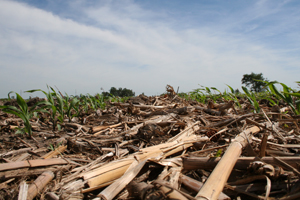No-till farming aims to improve soil structure, soil aggregate stability and biological activity (see this previous article summary), reduce soil erosion and retain greater amounts of nutrients. It has also shown improved carbon storage ability to help mitigate climate change compared to conventional farming. These factors have led to a number of studies looking to quantify these benefits as well as any associated negatives. One negative associated with no-till farming are reports of reduced crop yields. Balancing the pros and cons to decide whether it is better than conventional farming on balance, given the number of variables that could affect results, is a difficult but important and ongoing area of research.
No-till farming avoids disrupting the soil surface and leaving 30% or more of the crop residues on the surface of the land. This contrasts to conventional farming where, usually, machinery is used to dig in crop residues and loosen the soil in preparation for growing new crops.
A recent review in the Journal of Agricultural Science by researchers at the University of Nottingham examined 49 data sets from other research articles comparing soil organic matter content between no-till and conventional till farming, and another 61 sets of data from research comparing crop yield between the two farming methods. The purpose was to compare the asserted benefits on reducing greenhouse gases of no-till farming with the losses in yield.
Greenhouse gas emissions
In general, it was found that the carbon content of soils under no-till farming was greater than that of conventional farming. This resulted from carbon being retained in soil micro-aggregates which were in turn protected by macro-aggregates that, under conventional tilling, would have been broken up and the carbon more easily converted into carbon dioxide. The carbon was mostly retained in the upper layers but the longer the land was not tilled, the more long-lived was the sequestration.
Improvements in soil structure, aggregate stability and biological activity was confirmed but, in the case of the size and frequency of pores in the soil, the improvements came after tilling had ceased for a number of years.
However, the nitrification of soil nitrogen (turned from mineralised or stable soil nitrogen to nitrogen based greenhouse gases) increased under no-till farming. This is considered to be as a result of the increased anaerobic conditions (as the soil isn’t aerated by tilling). This is concerning as nitrous oxides have a significantly greater warming effect than carbon dioxide to the point where the gains in carbon sequestration could be less than the increase in nitrous oxides.
Longer term studies demonstrated that the longer the no-till farming endured, the ability of the biological and soil aggregation improvements to improve porosity and aeration of the soil resulted in lower nitrous oxide emission.
When comparing different greenhouses gases and their warming potential, a standard is used to allow direct comparison. This standard is the carbon dioxide equivalent, which can be calculated per unit of a particular greenhouse gas. A 30 year simulation showed an improvement of 0.56 tonnes of carbon dioxide equivalent per hectare per year under no-till farming, and a 43 year trial found a 1.03 tonne per hectare per year improvement, being a 52 per cent reduction of greenhouse gas emission compared to conventional farming.
Yield effects of no-till farming
The effect on yields is difficult to predict. Just over half of the studies the researchers looked at showed a decreased yield, just under half showed the opposite. Differences were noted between the effect on different crops, but a range of reductions between none and 30% were reported, with an average yield loss of 4.5% compared to conventional farming in the negative studies.
The major factors causing yield loss noted by the researchers were the increased susceptibility to weeds competing with crops, particularly seedlings, for nutrients. The shorter term anaerobic effects also increase water logging and reduced efficacy of fertilisers and pesticides (being unable to penetrate into the root zone).
Longer term studies showed increases in soybean yield over 10 years and comparable yields in wheat over 15 years, whilst another study showed that yield advantages under no-till were lost if the crop stubble was removed.
The difficulties of the effects on yield given different crops, different climates, different soil types and differing lengths of time under no-till mean that drawing a meaningful conclusion is difficult. However, it was noted in the article that there is the potential for yield increase when the benefits of no-till over longer periods on soil begin to show and if weed controls can be adequately implemented.
Conclusion
The article concludes with the observation that, as yet, we do not know when the net effect on greenhouse gas emissions moves from negative (increased nitrous oxide warming potential outweighs improve carbon storage) to positive. It appears that it takes some years for this to occur. Additionally, the improvements to soil structure also take some time to result in either slightly lower, comparable or better crop yields.
The hole in our current knowledge points to the need for a long-term study that notes the, say yearly for example, changes in carbon storage and nitrous oxide emissions to find the point in time where net difference on greenhouse gas emission is zero. At the same time, the improvements in soil structure, particularly the time required for anaerobic conditions in the soil to lessen and the associated issues that can reduce crop yield ease, needs to be ascertained. We can then be better placed to have some surety about what the long-term impacts of no-till farming will be on both issues and better inform ourselves on whether substantial improvements on either, or both, issues can be achieved and when.
 Farmers keep crop residues on their fields for the same reason home gardeners should consider them! Credit: Fabian Fernandez
Farmers keep crop residues on their fields for the same reason home gardeners should consider them! Credit: Fabian Fernandez 

